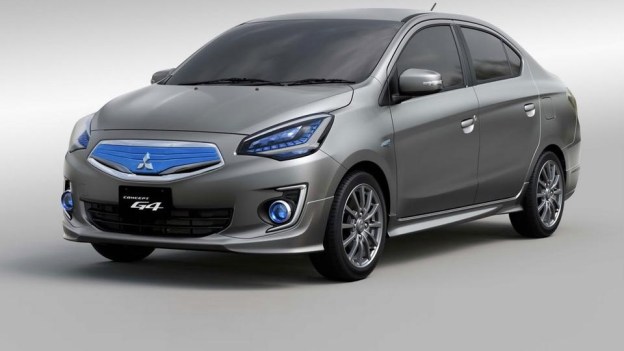 Mitsubishi continues to take baby steps toward relevance with its latest concept car. The G4, which will debut at the 2013 Shanghai Motor Show later this week, is an economical compact sedan. In other words, don’t expect it to set the world on fire.
Mitsubishi continues to take baby steps toward relevance with its latest concept car. The G4, which will debut at the 2013 Shanghai Motor Show later this week, is an economical compact sedan. In other words, don’t expect it to set the world on fire.
The G4 is close to being production ready, with only blue lights and a blue grille added for the show stand. The opaque grille suggests electrification, but the G4 will likely debut with conventional powertrains only. The rest of the car looks like a Nissan Versa sedan.
The sedan concept is closely related to the 2014 Mirage hatchback Mitsubishi showed at the New York Auto Show last month. It will share the Mirage’s 1.2-liter three cylinder engine, which produces 74 horsepower and 74 pound-feet of torque.
Mitsubishi says the Mirage will return 37 mpg city, 44 mpg highway, and 40 mpg combined. We expect similar numbers for the production G4.
After Shanghai, the G4 will get a name change (to Mirage sedan?) before going on sale in Europe and Asia. Mitsubishi hasn’t said whether the sedan will make it to the U.S., but it would be a good idea considering that the Ford Fiesta, Chevrolet Sonic, Hyundai Accent, and Kia Rio are all available as both hatchbacks and sedans.
It seems that, at least until the Outlander PHEV’s battery issues are resolved, Mitsubishi will rely on small displacement engines and lightweight chassis for fuel efficiency.

Mitsubishi used to be a full-line carmaker, but it has thinned its lineup in recent years to focus on affordable small cars and crossovers.
On the other hand, the rally-bred Lancer Evolution and the electric i-MiEV prove that Mitsubishi can load its cars with tech when it wants to, so maybe we’ll see a G4 plug-in hybrid down the road.
Do you think the G4 is a competent small car, or does Mitsubishi need to up its game? Tell us in the comments.


